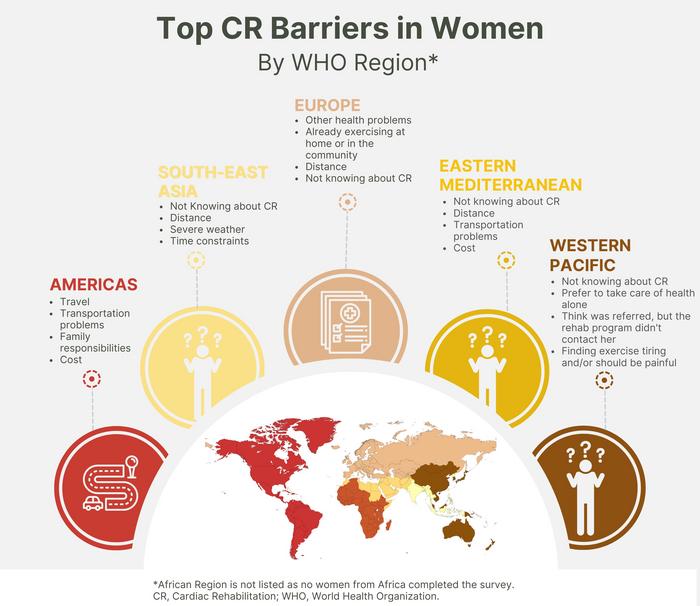Philadelphia, September 25, 2023 – Cardiovascular rehabilitation (CR) improves health outcomes and well-being and can reduce death and re-hospitalization rates by 20%. However, programs are underutilized and women are much less likely to participate than men, so they do not reap these benefits. This first global comparative study into barriers to using CR in men and women assesses the extent of these barriers and discusses ways in which patients can overcome them. It determined that women and men face some common, but also many different barriers, and barriers differ by global region. The study appears in the Canadian Journal of Cardiology, published by Elsevier.

Credit: Canadian Journal of Cardiology
Philadelphia, September 25, 2023 – Cardiovascular rehabilitation (CR) improves health outcomes and well-being and can reduce death and re-hospitalization rates by 20%. However, programs are underutilized and women are much less likely to participate than men, so they do not reap these benefits. This first global comparative study into barriers to using CR in men and women assesses the extent of these barriers and discusses ways in which patients can overcome them. It determined that women and men face some common, but also many different barriers, and barriers differ by global region. The study appears in the Canadian Journal of Cardiology, published by Elsevier.
Lead investigator Sherry L. Grace, PhD, CRFC, Faculty of Health, York University and KITE – Toronto Rehabilitation Institute, University Health Network, University of Toronto, explains: “The benefits of cardiac rehab participation are remarkable, plus patients get back their vitality and can return to their meaningful life roles. Unfortunately, women face many structural barriers to attending – from the individual to health system levels. We developed the Cardiac Rehab Barriers Scale (CRBS) almost 25 years ago to better characterize them, and it remains the most widely used and rigorous measurement scale to assess these barriers.”
While the CRBS has been translated into more than 20 languages, before the present study it had never been administered to patients in more than one country at a time and had only been administered in a total of 25 countries. There had only been two studies in which women’s and men’s barriers were compared.
Prof. Grace and co-lead investigator Gabriela Ghisi, PT, PhD, CRFC, also of KITE – Toronto Rehabilitation Institute, University Health Network, University of Toronto, add, “It was time to examine CR barriers on a global comparative basis to help us understand sex differences and women’s main barriers so we can address them, and hence have more women enrolling and fully participating in CR.”
In this cross-sectional study, the CRBS was administered globally via an online survey to over 2,000 patients from 16 countries across all six World Health Organization regions. Members of the International Council of Cardiovascular Prevention and Rehabilitation (ICCPR) community helped recruit participants by identifying cardiac inpatients who were eligible for CR and patients who were just starting CR. This is the first international study of CR utilization barriers, including data from all world regions, and presents the first quantitative barrier data from Africa as well as from several Western Pacific and European countries. About 42% of the participants were women.
The study’s findings show that although female cardiac patients have a somewhat greater burden of barriers in the Western Pacific and Americas than men, men and women have major barriers, which need to be addressed to optimize CR utilization. Women’s barriers were greatest in the Western Pacific and South East Asian regions compared to other regions, with lack of CR awareness as the greatest barrier in both. Men in the Eastern Mediterranean region reported greater barriers than women. Women who were unemployed reported significantly greater barriers than those who were employed.
Among women not enrolled in CR programs, their greatest barriers were not knowing about CR, program not contacting them after referral, cost, and finding exercise tiring or painful. Among women who were enrolled in a program, their greatest barriers to session adherence were distance, travel, family responsibilities, and difficulties in accessing sessions that require attendance in person (i.e., transportation).
Through the study — also for the first time — potential mitigation strategies to help overcome these barriers were provided to participants, such as talking with a healthcare provider about getting to a program or doing a home-based program. Over 70% of women and 40% of men rated the barrier-specific information provided as either “helpful” or “very helpful.” These observations should encourage the application of these types of mitigation strategies, as well as the development of further research on active mitigation strategies to improve adherence to CR programs.
Prof. Grace already has further research underway to test if the strategies to mitigate the main barriers identified can result in more CR participation. “We hope this will lead to more women enrolling in CR, and that would certainly positively impact their health outcomes and well-being.”
She urges, “Patients may have legitimate barriers to attending CR, but we recommend they discuss them with healthcare providers, as there are proven strategies to overcome them. Please help spread the word that CR is available in most countries of the world and saves lives!”
A resource for patients to assess their own barriers along with mitigation suggestions are provided on ICCPR’s website.
CR is a chronic disease management program where patients are supported by a team of healthcare professionals over several months through medical risk factor management, structured exercise, as well as patient education and counseling.
Journal
Canadian Journal of Cardiology
DOI
10.1016/j.cjca.2023.07.016
Method of Research
Survey
Subject of Research
People
Article Title
Women’s Cardiac Rehabilitation Barriers: Results of the International Council of Cardiovascular Prevention and Rehabilitation’s First Global Assessment
Article Publication Date
25-Sep-2023




